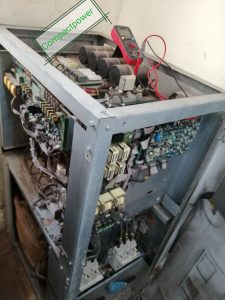
While the UPS provides critical power mainly to hold for a shorter period of time, Industrial inverter system has been designed for prolonged back up providing power to critical load in different forms relying on bigger battery banks. Reliability is always a crucial factor for such application as the load is always required to be available at all times or when needed. Below highlight factors affecting reliability with corrections along with steps to get best performance and increase longevity of your battery storage.
- Improper design and misapplication of components: the most important factor is good, careful design. Many field failures of electronic equipment are due to shortcomings in the design and in the application of components. Therefore more quality assurance can be achieved adopting a tested reliable solution from a known OEM during product selections. External factors such as occasional voltage spikes/surges do affect systems. Making the units rugged through careful design and controlled overstress allowance is a very important part of making the product reliable. Sound protection scheme provides immunity against intolerable external surge.
- Complexity: more components in a design/application increase chances of failure thereby reducing reliability. Make it as simple as possible.
- Under rated/improper charger: charger current needs proper sizing with combined battery Ah. Chargers rated higher than technically tolerable often lead to early battery failure same applies to under rated chargers. Therefore, a balanced system is required for longevity of your battery storage.
- Overly sized UPS batteries banks compared to OEM spec: there have been situations where larger batteries are used to replace OEM battery spec in UPS systems with an intention to achieve a higher backup time. Noble as it looks, end up harming the system as UPS charging current are usually too low to sufficiently charge such big battery banks.
- Repeated complete discharge cycle:totally eliminate if possible complete battery drain. That is, continuous use until UPS/Inverter shutdown. Though most UPS have low voltage power down circuit, not ideal to rely on this. Power down UPS/ inverter once low battery voltage alarm is intensified. For critical load application such as data center where 24/7 power availability is desired, size load and UPS backup so that it’s available until next charge cycle.
- Faulty electrical connections/ improper isolation:improper isolation of UPS loads often leads to back feed of current from the mains/source thereby impacting on UPS/inverter severally if not well protected. Engage professionals for proper isolation of load cables. Advised to provide protections both on the load side and input feed of the UPS/ inverter using well sized sensitive protection scheme.
- Improper float voltage:every battery manufacturer will specify the charging voltage ranges for own cell design. If a battery is consistently charged outside of these parameters, it can cause significant damage.
- Unfavorable equipment room/environment: high ambient temperature: The rated capacity of most battery is based on an ambient temperature of 25°C. Variations, but particularly increased temperature, can affect performance and lifespan. Others include humidity range of 40 to 60%rH. Equipment room has to be well conditioned based on best practices and operating requirements.
- Stress: UPS/Inverter being electronic equipment, common stresses are temperature, voltage, vibration and temperature rise due to current. Well controlled environment/equipment room with right temperature control and relative humidity guarantees increased reliability. Sound protection scheme provides immunity against intolerable external stress.